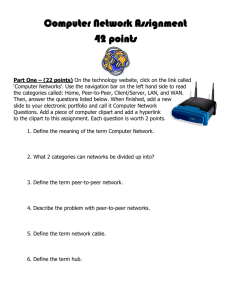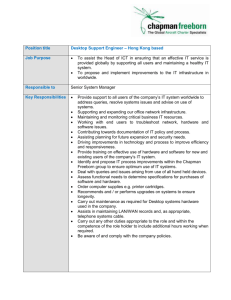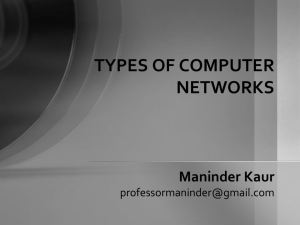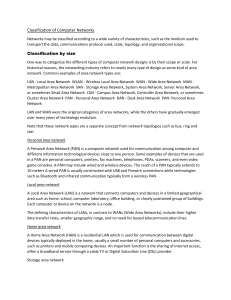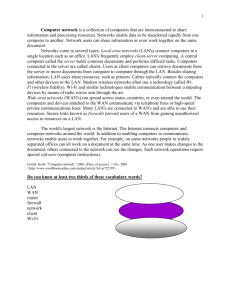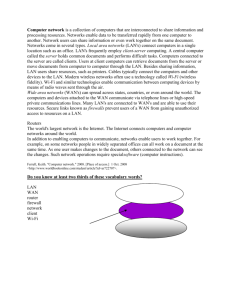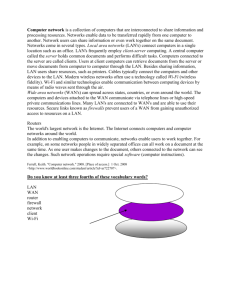Chapter 1 : Computer Networks.
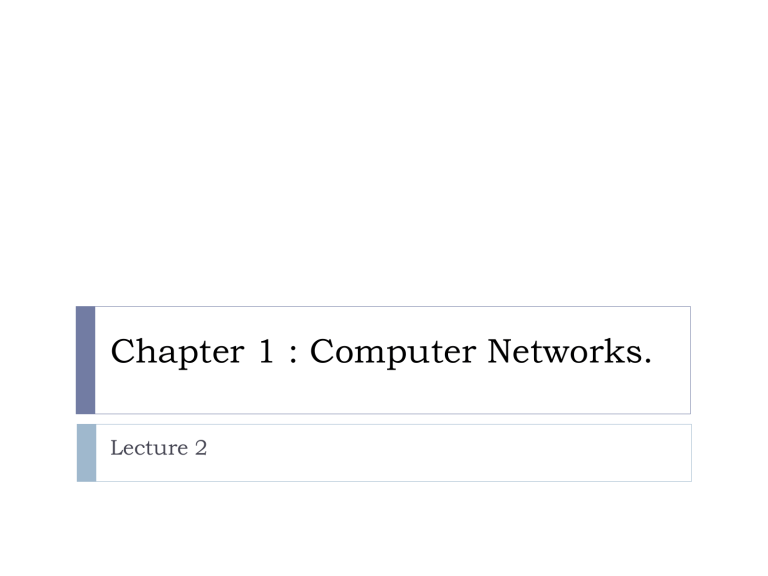
Chapter 1 : Computer Networks.
Lecture 2
Computer Networks Classification:
1- Depend on the geographical area.
2- Depend on functional relationship.
3- Depend on Network topology.
1- Depend on the geographical area.
1- Personal Area Network (PAN).
2- Local Area Network (LAN).
3- Metropolitan Area Network (MAN).
4- Wide Area Network (WAN).
1- Personal Area Network (PAN):
- A personal area network (PAN) is a computer network that used for communication among computer and different information technological devices close to one person.
Examples of devices that are used in a PAN: personal computers, printers, fax machines, scanners, video game consoles.
1- Personal Area Network (PAN):
- PAN may include wired devices (constructed with USB connections) and wireless devices (constructed with
Bluetooth).
- PAN typically extends to 10 meters.
2- Local Area Networks (LAN).
-
A LAN is a group of computers, printers and other interconnected devices located in a single room, several rooms within a building or several buildings of a campus.
- IEEE (Institute for Electrical and Electronics Engineers) qualifies LAN length as 10 km or less in radius.
2- Local Area Networks (LAN).
-
Characteristics of a LAN include:
• Limited geographic operation.
• High speed data transfer rates.
• Generally lower in cost than a WAN.
• Cabling is primary transmission medium.
2- Local Area Networks (LAN).
3- Metropolitan Area Network (MAN).
- MAN (Metropolitan Area Network) is a network that interconnects users with computer resources in a geographic area or region larger than that covered by even a large local area network (LAN) but smaller than the area covered by a wide area network (WAN).
- It covers large geographic areas , such as city.
3- Metropolitan Area Network (MAN)
4- Wide Area Network (WAN).
- Wide Area Networks (WANs) extend beyond the LAN to connect networks located in different cities, states, and countries together.
- WANs are used to connect LANs and other types of networks together, so that users and computers in one location can communicate with users and computers in other locations .
4- Wide Area Network(WAN)
The Internet is an example of WAN.
The Internet : is a global system of interconnected computer networks that used to exchange information using (TCP/IP) protocol.
4- Wide Area Network (WAN).
14
2- Depend on functional relationship.
1- Peer-to-Peer Network.
2- Client/Server Network.
1- Peer-to-Peer Network:
- A peer-to-peer network consists of a group of computers, each one can act as both client and server.
- Great for small, simple, and inexpensive networks.
- In a strict peer-to-peer networking setup, every computer is an equal, a peer in the network.
- Each computer can have resources (such as files and printers) that are shared with any other computer.
1- Peer-to-Peer Network:
- The P2P networks are connected with a simple and visible cabling system. The users can then administer their own computers and the resources they want to share on the network.
- Examples of P2P OS are : Windows 95,Windows for
Workgroups and Windows NT Workstation.
Peer-to peer network (cont..)
2- Client/Server Network :
Client and Server computer role in networking:
- Server computer : is a core component of the network, providing a link to the resources necessary to perform any task.
- Client computers normally request and receive information over the network depends on the server.
2- Client/Server Network :
- A client/server network consists of a group of PCs (called clients), that send the requests to the server .
- The server’s function on the network is to service these requests.
- The server often has a faster CPU, more memory, and more disk space than a typical client.
- Example of client/server-based network is Windows NT
Server.
2- Client/Server Network :
The types of servers:
1- File server :
- It serves the users to share computer programs and data.
- It should have hard disk capacity, large memory, and a powerful processor so they can handle the needs of many users.
2- A database server :
- It is a computer that stores a database on disk and makes the data accessible by multiple users.
2 -Client/Server Network :
3- Mail Server :
- Mail servers provide e-mail, chat …etc services to the users.
4- A print server :
- It is a device that connects printers to client computers over a network. It accepts print jobs from the computers and send the jobs to the appropriate printers.
5- Internet Information Server/web server :
- A web server provides the workstation users access to the
Internet web site of the company or organization. This web site if registered can be accessed by Internet.
